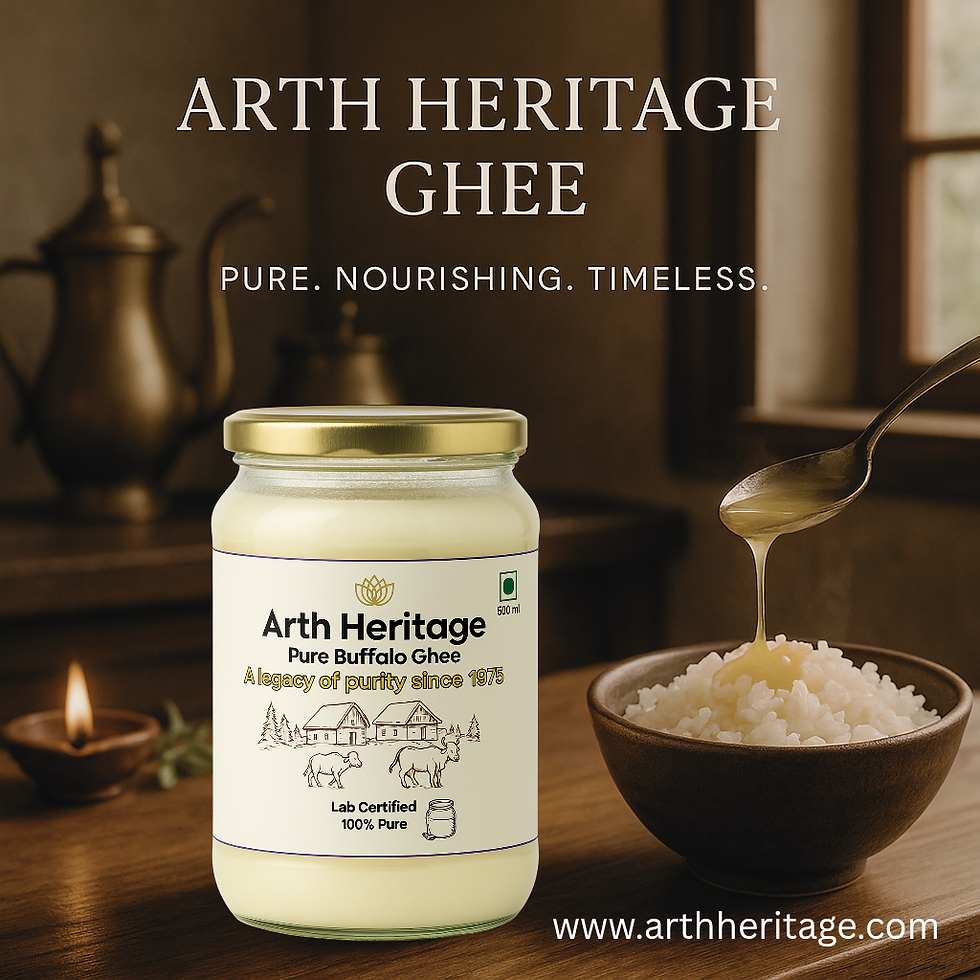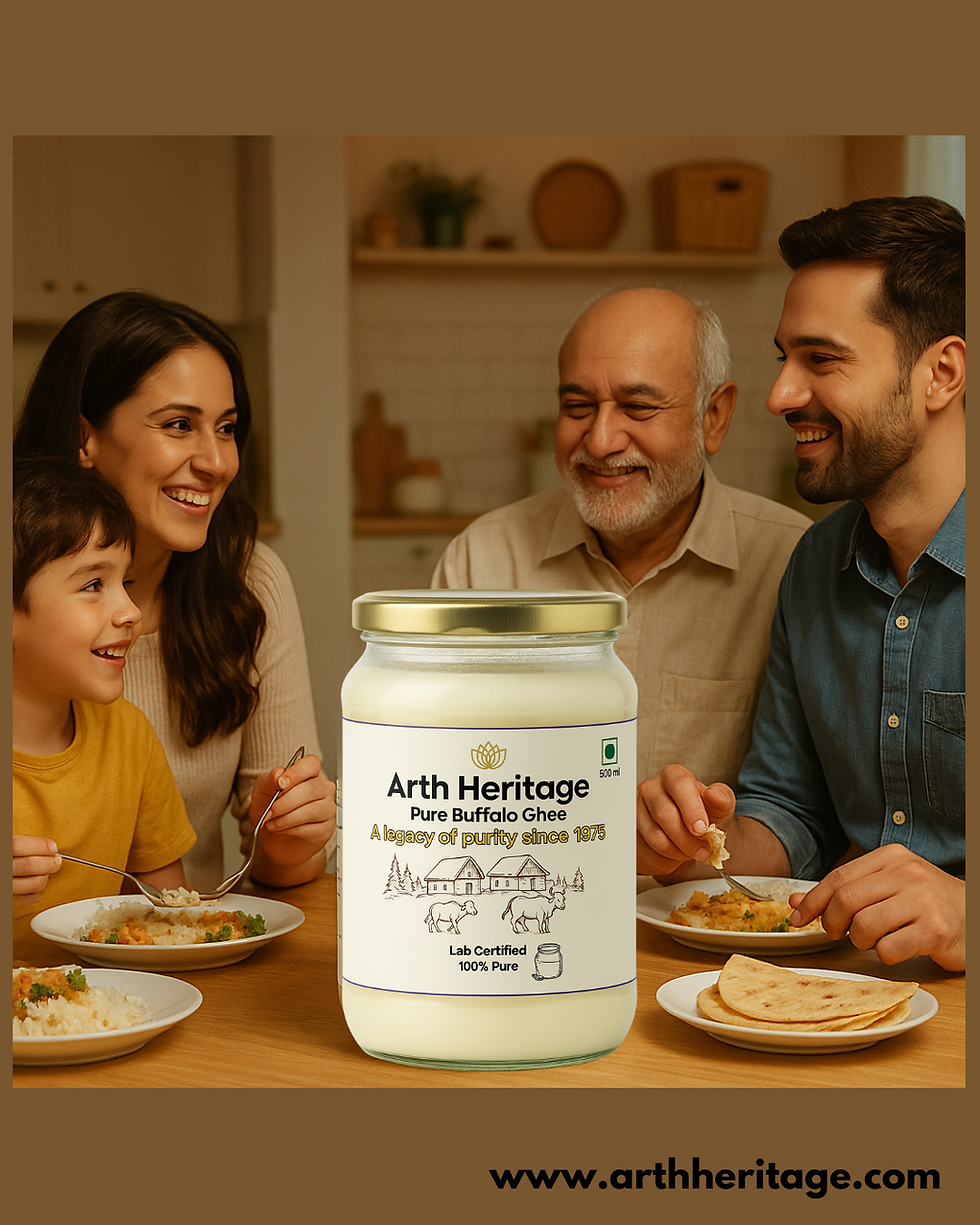Explore the Richness of Buffalo Ghee in Indian Cuisine
- Arth Heritage
- Jun 22
- 4 min read
Updated: Jun 24
In Indian cuisine, buffalo ghee holds a special place—it's not just a cooking medium but a core ingredient that elevates dishes with its rich flavor and numerous health benefits. Making buffalo ghee from fresh buffalo milk is an age-old practice in India, renowned for its distinct aroma, nourishment, and culinary applications. This blog post delves into the various aspects of buffalo ghee, highlighting its benefits, nutritional value, and its role in traditional Indian cooking.
Buffalo Ghee Benefits
The use of buffalo ghee offers a bounty of health benefits. It is rich in vitamins A, D, E, and K, alongside a host of essential fatty acids. These nutrients play a crucial role in maintaining our overall health. For instance, vitamin A is vital for good vision and supports skin health. Vitamin D aids in calcium absorption, which is fundamental for bone strength.
Moreover, buffalo ghee contains butyrate, a type of short-chain fatty acid known for its anti-inflammatory properties. Studies suggest that regular consumption of butyrate can help reduce the risk of certain diseases, including cancer and heart disease. The richness of ghee also makes it an excellent source of energy, providing fuel for daily activities.

The traditional practice of using buffalo ghee in cooking goes beyond flavor; it also enhances digestion. Ghee is known to help soothe the digestive tract, which can lead to improved gut health. Many people in India swear by it for alleviating acidity and reducing digestive issues.
Culinary Applications of Buffalo Ghee
Buffalo ghee has a unique flavor profile that enhances various Indian dishes. It is widely used in both savory and sweet recipes. From biryanis to sabzis, adding buffalo ghee not only elevates flavor but also enriches the texture and aroma of the meal.
For instance, in North India, dishes like dal makhani and paneer tikka are often cooked using ghee, providing them with a luxurious mouthfeel. In South India, ghee is used in preparing dosa and various rice dishes, contributing to that authentic taste.
The rich flavor of buffalo ghee also makes it an excellent base for frying and tempering spices. The high smoke point of ghee allows it to be heated to high temperatures without breaking down, making it ideal for frying and sautéing.

One of the most celebrated uses of buffalo ghee is in sweets and desserts. Traditional Indian sweets like opulent gulab jamun and rich ladoo often incorporate ghee, which adds depth to the flavors. Not only does it enhance taste, but it also contributes to a moist texture that is simply irresistible.
How much protein is in 1 kg of Buffalo Ghee?
One of the frequently asked questions about buffalo ghee is its protein content. It's important to note that ghee is primarily composed of fat, and while it does contain some proteins, the amount is relatively low.
In fact, 1 kg of buffalo ghee typically contains about 1-2% protein by weight. This translates to approximately 10-20 grams of protein. However, the primary nutritional benefits of ghee come from its rich fat content, vitamins, and fatty acids rather than protein. Thus, while buffalo ghee can contribute to your overall dietary protein intake, it should not be relied upon as a primary protein source.
Nutritional Value of Buffalo Ghee
Buffalo ghee is not just about flavor; it packs a punch in terms of nutrition. Per tablespoon of buffalo ghee, you typically get:
Calories: Approximately 112 calories
Fat: About 12.7 grams, with around 8 grams of saturated fat
Vitamins: Rich in vitamins A, D, E, and K
These nutrients contribute to various bodily functions, such as maintaining healthy skin, supporting the immune system, and improving cardiovascular health.
Additionally, buffalo ghee contains antioxidants that help neutralize free radicals in the body, thereby reducing oxidative stress and inflammation. Including buffalo ghee in moderation can be an excellent way to increase caloric intake without compromising nutritional quality.

Incorporating Buffalo Ghee into Your Diet
If you're looking to include buffalo ghee in your diet, there are plenty of simple ways to do so. Here are a few actionable recommendations:
Start Your Day Right: Use buffalo ghee instead of butter or oil on toast or in eggs for breakfast. It adds a nutty flavor that will invigorate your morning routine.
Cook Your Favorite Dishes: Swap your regular cooking oil for buffalo ghee when sautéing vegetables or making curries. You will notice a significant difference in taste and fragrance.
Make Flavorful Rice: Cook rice dishes like pulao or biryani with buffalo ghee for an extra layer of flavor. It's a simple way to elevate your meals.
Indulge in Desserts: Use buffalo ghee in traditional Indian sweet recipes. Whether you’re making halwa, barfi, or laddu, ghee will enhance the taste and texture profoundly.
Enjoy with Bread: A dollop of buffalo ghee on freshly baked bread or rotis can transform a simple meal into an unforgettable experience.
Health Supplements: If you prefer, consider taking buffalo ghee as a supplement. Some people enjoy consuming a teaspoon of it daily for overall wellness.
Incorporating buffalo ghee into your cooking not only enhances the taste of your meals but also provides numerous health benefits.
Reap the Benefits of Buffalo Ghee
In conclusion, buffalo ghee is more than just an ingredient; it’s a vital part of Indian culinary heritage. The myriad benefits—from its rich flavor to its nutritional properties—make it a valuable addition to any diet. Making this switch can change your culinary experiences while boosting your health.
Embrace this traditional ingredient and experience the warmth and richness that buffalo ghee brings to your kitchen and your health.
For further details on buffalo ghee and its uses, you can check out buffalo ghee.

Comments